Solar eclipse of August 20, 1952
An annular solar eclipse occurred on August 20, 1952. A solar eclipse occurs when the Moon passes between Earth and the Sun, thereby totally or partly obscuring the image of the Sun for a viewer on Earth. An annular solar eclipse occurs when the Moon's apparent diameter is smaller than the Sun's, blocking most of the Sun's light and causing the Sun to look like an annulus (ring). An annular eclipse appears as a partial eclipse over a region of the Earth thousands of kilometres wide. Annularity was visible from Peru including the capital city Lima, northeastern Chile, Bolivia including the constitutional capital Sucre and seat of government La Paz, Argentina, Paraguay, southern Brazil and Uruguay.
| Solar eclipse of August 20, 1952 | |
|---|---|
 Map | |
| Type of eclipse | |
| Nature | Annular |
| Gamma | -0.6102 |
| Magnitude | 0.942 |
| Maximum eclipse | |
| Duration | 400 sec (6 m 40 s) |
| Coordinates | 21.7°S 64.1°W |
| Max. width of band | 264 km (164 mi) |
| Times (UTC) | |
| Greatest eclipse | 15:13:35 |
| References | |
| Saros | 144 (13 of 70) |
| Catalog # (SE5000) | 9403 |
Related eclipses
Solar eclipses of 1950–1953
This eclipse is a member of a semester series. An eclipse in a semester series of solar eclipses repeats approximately every 177 days and 4 hours (a semester) at alternating nodes of the Moon's orbit.[1]
| Solar eclipse series sets from 1950–1953 | ||||||
|---|---|---|---|---|---|---|
| Ascending node | Descending node | |||||
| Saros | Map | Saros | Map | |||
| 119 | 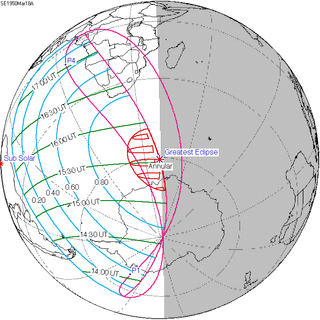 March 18, 1950 Annular (non-central) |
124 | 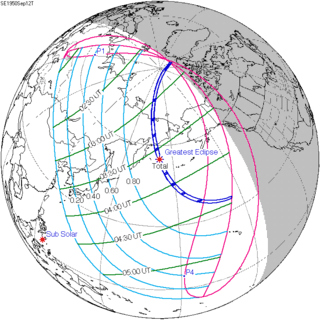 September 12, 1950 Total | |||
| 129 |  March 7, 1951 Annular |
134 |  September 1, 1951 Annular | |||
| 139 |  February 25, 1952 Total |
144 |  August 20, 1952 Annular | |||
| 149 |  February 14, 1953 Partial |
154 |  August 9, 1953 Partial | |||
| Solar eclipse of July 11, 1953 belongs to the next lunar year set | ||||||
Saros 144
It is a part of Saros cycle 144, repeating every 18 years, 11 days, containing 70 events. The series started with partial solar eclipse on April 11, 1736. It contains annular eclipses from July 7, 1880 through August 27, 2565. There are no total eclipses in the series. The series ends at member 70 as a partial eclipse on May 5, 2980. The longest duration of annularity will be 9 minutes, 52 seconds on December 29, 2168.
| Series members 11–21 occur between 1901 and 2100: | ||
|---|---|---|
| 11 | 12 | 13 |
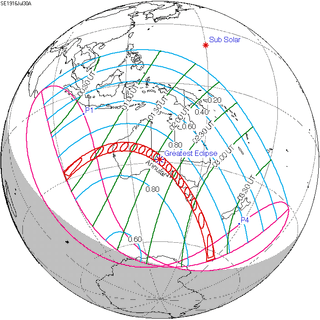 Jul 30, 1916 |
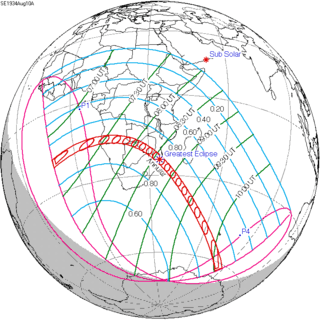 Aug 10, 1934 |
 Aug 20, 1952 |
| 14 | 15 | 16 |
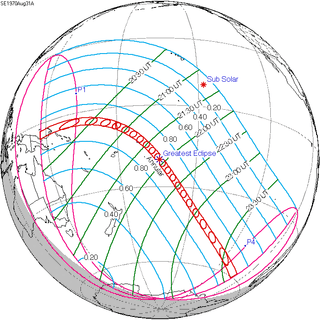 Aug 31, 1970 |
 Sep 11, 1988 |
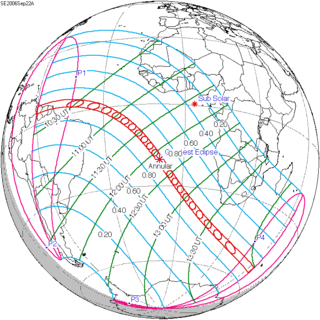 Sep 22, 2006 |
| 17 | 18 | 19 |
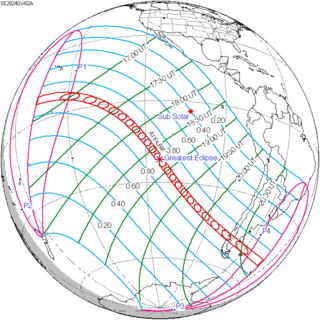 Oct 2, 2024 |
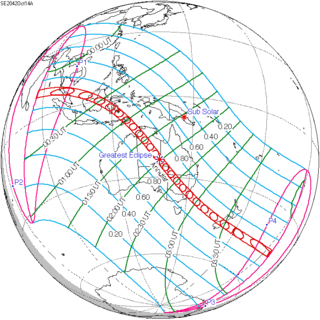 Oct 14, 2042 |
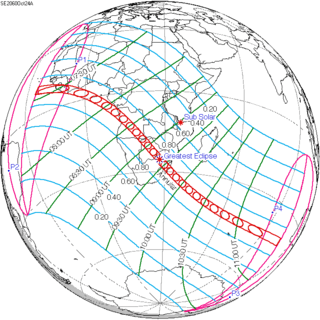 Oct 24, 2060 |
| 20 | 21 | |
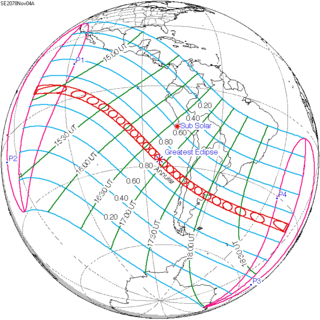 Nov 4, 2078 |
 Nov 15, 2096 | |
Notes
- van Gent, R.H. "Solar- and Lunar-Eclipse Predictions from Antiquity to the Present". A Catalogue of Eclipse Cycles. Utrecht University. Retrieved 6 October 2018.
References
- Earth visibility chart and eclipse statistics Eclipse Predictions by Fred Espenak, NASA/GSFC
.jpg)
